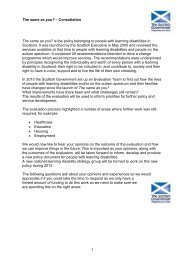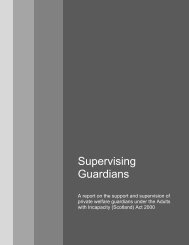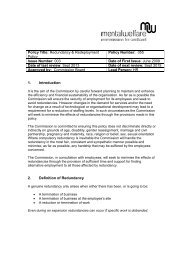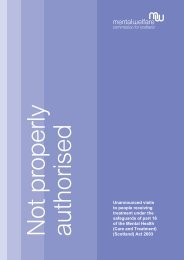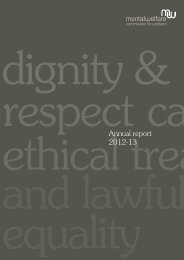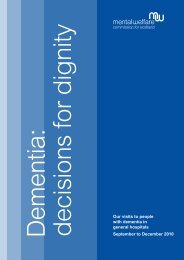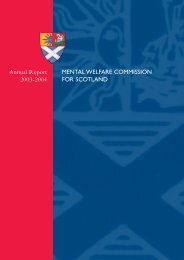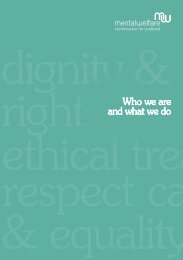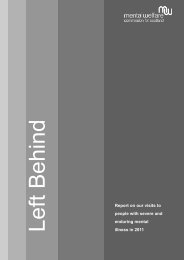Safe to wander - Mental Welfare Commission for Scotland
Safe to wander - Mental Welfare Commission for Scotland
Safe to wander - Mental Welfare Commission for Scotland
- No tags were found...
You also want an ePaper? Increase the reach of your titles
YUMPU automatically turns print PDFs into web optimized ePapers that Google loves.
5<strong>to</strong> discuss such risks and <strong>to</strong>help the person <strong>to</strong> understandthe benefits of technologysolutions. Care-givers shouldmake a careful record ofsuch discussions includingwhether the person agreesor disagrees with the useof technology. This must beapproached with sensitivityand only after the person hashad time <strong>to</strong> come <strong>to</strong> termswith his or her diagnosisand its implications.The views of relevant othersshould be taken in<strong>to</strong> accountA wide range of people willhave valuable roles <strong>to</strong> playin the decision on whether<strong>to</strong> use <strong>wander</strong>ing technology,including:• Nearest and close relativesand friends will knowthe person best andcan provide valuablein<strong>for</strong>mation about his/herlife. This may be crucial inunderstanding the person’sbehaviour. They will alsohave views about risks anddignity and these shouldbe taken in<strong>to</strong> account.• A welfare at<strong>to</strong>rney orguardian with powersover the person’s welfaremay have the authority<strong>to</strong> consent <strong>to</strong> the useof <strong>wander</strong>ing technology.Even where a specificpower is not included inthese granted these mayinclude decisions onthe person’s place ofresidence, which may beaffected by the potentialuse of technology. In suchcases it is important <strong>to</strong>consult such a person onthe use of technology.• Professional carers willhave experience inmanaging <strong>wander</strong>ingbehaviour, in particular theiradvice on environmentaldesign or modificationsand assessment of riskwill aid the decisionmaking process.The intervention shouldencourage the person <strong>to</strong> useexisting skills and developnew onesThis principle is <strong>to</strong> beobserved by at<strong>to</strong>rneys,guardians and managersof care establishments,and represents good practice<strong>for</strong> anyone involved in theperson’s care. If the useof technology <strong>to</strong> manage<strong>wander</strong>ing behaviourincreases the opportunity<strong>for</strong> the person <strong>to</strong> use existingskills and <strong>to</strong> develop newones, then it merits seriousconsideration.Considering the use of<strong>wander</strong>ing technology:assessment and careplanningPrior <strong>to</strong> introducing any<strong>wander</strong>ing technologysystem there should becareful physical andpsychological assessment<strong>to</strong> eliminate any reversiblecause of the <strong>wander</strong>ingbehaviour. This assessmentwould involve analysing whatis actually happening, whenit is happening, what triggersthe behaviour and whatintervention helps.• Physical assessmentAny physical assessmentsshould be multi-disciplinaryand should include:Medication reviewMany medications <strong>for</strong> bothphysical and psychiatricconditions have side-effectswhich can include mo<strong>to</strong>rrestlessness, confusion andconstipation amongst others.All of these side-effectscan contribute <strong>to</strong> thedevelopment of worsening<strong>wander</strong>ing behaviour andmedications should beregularly reviewed by themedical practitioner(particularly those supplied<strong>for</strong> the treatment of anxiety,depression and insomnia).



